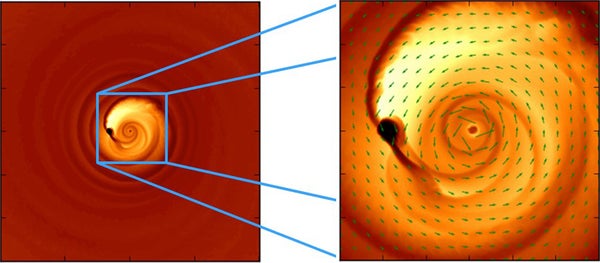At the heart of a galaxy 3.5 billion light-years away, a black hole may be careening at an insane speed around another one 10 times its size. With less than the length of our solar system separating them, this possible binary black hole system looks to be the closest pair ever spotted, suggesting the two black holes might be on a collision course that would unleash ripples throughout the fabric of spacetime and help researchers understand how galaxies combine.
Astronomers have been hunting for binary black holes for more than a decade, and this is the most promising one yet. This putative black hole pair, described in the September 17 issue of Nature, is probably responsible for the strange behavior of a particular quasar, an extremely energetic region of dust and space debris at the center of a galaxy, the research team says. Quasars, thought to be powered by a black hole (or two), typically flicker from bright to dim seemingly at random, as the amount of mass their black holes are consuming rises and falls. But in this case, unusually regular, or periodic, light emissions were seen, suggesting that a black hole binary might call the quasar home. (Scientific American is part of Nature Publishing Group.)
This quasar, cumbersomely labeled PG 1302-102, along with more than 100 other quasars exhibiting unusual periodic behavior were discovered by a team of researchers at California Institute of Technology. Matthew Graham, a computational scientist, along with colleagues published the results earlier this year. PG 1302-102 stood out from the rest as the most likely to have a black-hole binary at its center due to its particularly strong periodic signal. The quasar’s brightness spiked 14 percent about every five years, so Graham’s team suspected a black hole binary was the cause.
On supporting science journalism
If you're enjoying this article, consider supporting our award-winning journalism by subscribing. By purchasing a subscription you are helping to ensure the future of impactful stories about the discoveries and ideas shaping our world today.
A team at Columbia University, intrigued by the Caltech team’s findings, determined how a black hole binary could cause that spike. “Once you find this periodic behavior, you can look at other pieces of evidence and try to pin down a model for how the binary is causing that variation of light,” says Daniel D’Orazio, an astronomy graduate student and the lead author for the latest paper. They propose a pairing of a black hole orbiting an extremely massive one. Because one black hole is significantly smaller and they orbit so closely, the smaller one whips around its larger partner at an estimated 7 percent of the speed of light—extremely fast.
Doppler beaming, the process wherein matter moving close to light-speed appears to change in brightness based on its position, explains the quasar’s periodicity. This phenomenon is the visual equivalent of how a siren seems to sound higher and louder as it zooms toward an observer but lower and softer as it rushes away. The quasar’s bright peaks occur when the light given off by gases swirling around the smaller black hole points in Earth’s direction, like a lighthouse beam.
Although there have been other close-orbiting black-hole binary candidates, such as the even more ponderously named PSO J334.2028+01.4075, the Doppler beaming explanation for this new candidate makes this one far more compelling. According to Graham, it “is not an effect you would see if this is just a single supermassive black hole.” The team also used their model to predict how ultraviolet light emitted by the quasar would vary and then checked their result against 20 years of data. Their model’s prediction was spot-on.
Black hole binary systems with small separations could help researchers understand what happens as such massive objects ultimately crash together. Black hole collisions are one of the universe’s primary sources of gravitational waves, ripples in spacetime predicted by general relativity but never directly observed.
Understanding these collisions will also help researchers determine how many binaries they should expect to see in the future. “If the orbits erode very fast, we expect only rarely to find binaries when they’re still binaries and haven’t merged,” astronomer Zoltan Haiman, one of the Columbia paper’s authors, says. “If they erode slowly, we expect to find many.”
Presently, a black hole binary is not the only explanation for quasar PG 1302-102’s odd behavior. Alternative causes could include warping in the disc of matter around the black hole, a hot spot in that so-called accretion disc or random noise that nonetheless resembles a periodic signal like a sine wave. “The one smoking gun that I think everybody agrees on is gravitational waves observation,” says Jeremy Schnittman, a theoretical astrophysicist at NASA unaffiliated with this study. He also models black hole binary behavior. “That’ll really be the only way you ever know something is a binary black hole,” he adds.
Any effort to observe gravitational waves from this system, however, would require equipment that is still a few years off. Current detectors are not sensitive enough to pick up on the weak waves the black holes would emit if they were slowly spiraling toward a crash. Within five or 10 years, however, equipment sensitive enough to pick up on PG 1302-102’s possible gravitational waves, and the waves from the many potential systems like it, will likely exist. And maybe then black hole binaries will finally have their day.
